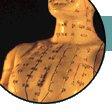Differentiation of Syndromes according to the Eight Principles
The eight principles of differentiating syndromes are yin and yang,
exterior (biao) and interior (li), xu (deficiency) and shi (excess),
and cold and heat. These eight basic syndromes signify the location of
pathological changes, the nature of disease, the condition of body
resistance and pathogenic factors. These are the general principles
for differentiation of syndromes and no matter how complex the disease,
the eight principles can be used to give an analysis and differentiation.
1. Exterior and Interior
Exterior and interior are two principles indicating the depth and
development of disease. Exterior syndromes refer to the pathological
changes and syndromes which are caused by the invasion of the body
surface by exogenous pathogenic factors.
Exterior syndromes are usually acute accurrences, superficially located, and with a short duration. The main clinical manifestations are aversion to cold and fever, thin and white tongue coating, floating pulse, etc.
Interior syndromes result from the transmission of exogenous pathogenic factors into the interior or from the dysfunction of the zang-fu organs.
Interior syndromes have extensive indications. Regarding the occurrence of disease, there are three conditions:
(1) Interior syndromes may occur due to transmission of exogenous pathogenic factors into the interior after lengthy contact.
(2) They may result from direct accack on the zang-fu organs by exogenous pathogenic factors.
(3) Dysfunction of zang-fu organs may also be due to interior syndromes.
2. Cold and Heat
Cold and heat are two principles for differentiating the nature of
disease.
Cold syndromes are pathological changes and symptoms caused by exogenous pathogenic cold or constitutional yang deficiency. Clinical manifestations of cold syndromes are: aversion to cold and preference for warmth; tastelessness in the mouth; absence of thirst; pallor; cold extremities; clear and profuse urine; loose stool; pale tongue proper with a white slippery coating; slow pulse, etc. These are all signs of excessive yin.
Heat syndromes are caused by exogenous pathogenic heat or constitutional yin deficiency. The symptoms of heat syndromes include: fever; preference for cold; thirst with preference for cold drinks; flushed cheeks and redness of the eyes; yellowish and scanty urine; constipation; red tongue proper with a dry yellowish coating; rapid pulse, etc. These are signs of preponderant yang.
3. Xu (deficiency) and Shi (Excess)
Xu (deficiency) and shi (excess) are two principles which are used to
analyze the strength or weakness of body resistance and the pathogenic
factors during the process of disease development.
Generally, syndromes of the xu type indicate diseases and symptoms caused by the weakness and insufficiency of body resistance. Syndromes of the shi type refer to diseases and symptoms induced by an overabundance of exogenous pathogenic factors. Xu syndromes are mainly due to an insufficiency of antipathogenic factors when exogenous pathogenic factors are also in a weakened state. Shi syndromes are mainly due to an excess of exogenous pathogenic factors, with body resistance not yet weakened. Mixture syndromes of xu and shi also occurs.
Xu syndromes can be further classified into qi deficiency, blood deficiency, yang deficiency, and yin deficiency with varied clinical manifestations. Shi syndromes may be caused by qi stagnation, blood stasis, phlegm obstruction, stagnancy of water, and parasites with complex clinical manifestations. Different types of xu and shi syndromes have been introduced in related chapters. The general xu syndromes include lassitude, emaciation, sluggishness, pale complexion, palpitation, shortness of breath, spontaneous sweating, night sweating, insomnia, poor memory, loose stool, frequent urination or incontinence of urine, pale tongue proper without coating, thready and weak pulse, etc.
Shi syndromes generally include coarse breathing, irritability, sonorous voice, pain and distension in the chest and abdomen, pain and distension aggravated by pressure, constipation, dysuria, thick and sticky tongue coating, forceful shi pulse, etc. However, the patient's body can still remain strong and vigorous.
4. Yin and Yang
Yin and yang are two general principles used to categorize the other
six principles, i.e., exterior, heat and shi belong to the category of
yang, while interior, cold, and xu belong to yin. Yang syndromes and
yin syndromes can be detailed as the collapse of yin, collapse of yang,
yin xu (yin deficiency), yang xu (yang deficiency), etc.
Yin xu and yang xu syndromes: Yin xu indicates consumption or loss of yin fluid. yan xu manifests as the insufficiency of yang qi. Yin xu syndromes are afternoon fever, malar flush, feverish sensation in the palms and soles, irritability, insomnia, night sweating, dry mouth and throat, scanty and yellowish urine, dry stool, red tongue proper with little coating, and thready and rapid pulse. Since yin xu syndromes include internal heat, they are also known as xu heat syndromes.
Yang xu syndromes are manifested by chills, cold extremities, tastelessness in the mouth, absence of thirst, pale complexion, spontaneous sweating, profuse and clear urine, loose stool, and pale tongue proper. Thus while yang xu syndromes indicate inadequate yang qi, they are also termed syndromes of xu cold.
Generally, symptoms characterized by excitation, restlessness, hyperactivity, and optimism belong to yang syndromes, while those characterized by inhibition, quietude, decline, and gloominess are yin.
Yang collapse and yin collapse syndromes: Yang and yin collapse syndromes are dangerous signs during the progress of a disease. Yin collapse indicates an excessive loss of vital essence and nutrient fluid. Yang collapse causes pathological changes and symptoms due to the profuse consumption of body yang qi. Both may occur at the final stage of some chronic diseases or may appear in the crisis stage of some acute diseases. Because of the interdepending relationship of yin and yang, a collapse of one could lead to the collapse of the other. Therefore, the occurrence of these syndromes might be simultaneous with only the difference of early or late appearance.
Besides the symptoms of primary disease, collapses of yang and yin are both manifested by different degrees of perspiration. The perspiration in yin collapse is characterized by a type of sticky hot sweat, accompanied by hot skin, warm hands and feet, thirst with preference for drinks, malar flush, and a thready, rapid, forceless pulse. These are signs of yin fluid exhaustion. Yang collapse perspiration is notable for dripping sweat, thin cold sweats, accompanied by aversion to cold, lying with the body curled up, cold extremities, listlessness, pale complexion, and feeble pulse, all of which are signs of yang qi prostration.
The syndromes of each of the eight principles are varied, but are closely related to each other in clinical application. For example, when differentiating syndromes of exterior and interior, the syndromes of cold, heat, xu, and shi are also involved; the differentiation of xu and shi syndromes is also involved with syndromes of cold, heat, exterior, and interior.
During the process of disease development, sometimes there will be non-conformity between the nature and the manifestation of a disease; for example, in syndromes of pseudo-cold and real heat, syndromes of real cold and pseudo-heat, etc. So attention should be paid to the pseudo-phenomena when a disease has developed to a serious stage. Differentiation of syndromes according to the eight principles should be used actively to prevent deception by the pseudo-phenomena of a disease.
|

 This website is published, edited and designed by Raymond Cheng,
and reflects only and only his personal views and opinions in his individual capacity.
The information available at this website is not intended
directly or by implication to either diagnose or treat any
medical, emotional, or psychological condition or disorder.
It is also not intended to create a physician-patient relationship
between you and I or between you and Wyith Institute™ and The Office of Dr Raymond K K Cheng.
The information here is not a substitute for advice and treatment provided
by your physician or by another healthcare professional.
It is always recommended that consultation with local healthcare providers
be obtained for any of your specific health or medical concerns.
Furthermore, any products that can be purchased (yet you can see I don't have much
to sell here) through advertisers' banners or through links to other websites
are not either explicitly or implicitly given any warranty or endorsement
by me, my colleagues, Wyith Institute™ or any of its associated businesses.
This website is published, edited and designed by Raymond Cheng,
and reflects only and only his personal views and opinions in his individual capacity.
The information available at this website is not intended
directly or by implication to either diagnose or treat any
medical, emotional, or psychological condition or disorder.
It is also not intended to create a physician-patient relationship
between you and I or between you and Wyith Institute™ and The Office of Dr Raymond K K Cheng.
The information here is not a substitute for advice and treatment provided
by your physician or by another healthcare professional.
It is always recommended that consultation with local healthcare providers
be obtained for any of your specific health or medical concerns.
Furthermore, any products that can be purchased (yet you can see I don't have much
to sell here) through advertisers' banners or through links to other websites
are not either explicitly or implicitly given any warranty or endorsement
by me, my colleagues, Wyith Institute™ or any of its associated businesses.



 Thank you for visiting this TCM and acupuncture information website.
If you have previously been to this website, you might have
noticed that some of the pages on ancient historical ideas and
holistic thinkings related to Chinese metaphysics are temporarily taken offline.
This is because I will be revamping the whole website and be moving
those information into a new \"Ancient Chinese Culture\" section
so as to reflect a more current perspective on the interpretation
of some of the fundamental concepts as well as to include
some of the latest information in the area.
But if you have just found this website for the very first time, I welcome you again and
wish you could find what you require and, hopefully, you could also be benefitted
from reading the articles I published on this website.
Thank you for visiting this TCM and acupuncture information website.
If you have previously been to this website, you might have
noticed that some of the pages on ancient historical ideas and
holistic thinkings related to Chinese metaphysics are temporarily taken offline.
This is because I will be revamping the whole website and be moving
those information into a new \"Ancient Chinese Culture\" section
so as to reflect a more current perspective on the interpretation
of some of the fundamental concepts as well as to include
some of the latest information in the area.
But if you have just found this website for the very first time, I welcome you again and
wish you could find what you require and, hopefully, you could also be benefitted
from reading the articles I published on this website.